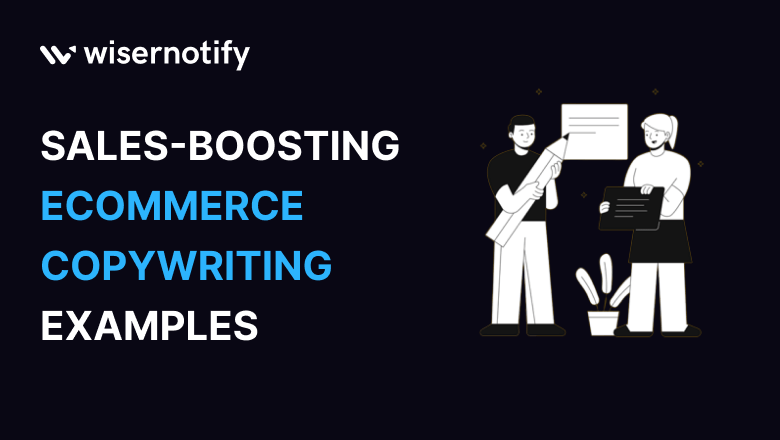The language and words you use on your eCommerce website or app can have a gigantic impact on your business.
A well-written copy can persuade someone to buy something; a poorly written copy can turn them away for good.
That’s why eCommerce companies are hiring specialized copywriters — the right words can make all the difference.
Hence, here are the top 10 eCommerce copywriting examples that will skyrocket your sales.
Visitors leave your website without taking action?
They don’t trust your site or feel urgency to act. WiserNotify builds both, turning doubt into action & visitors into customers.
What is eCommerce Copywriting?
eCommerce writing or copywriting is the art of writing engaging, persuasive, and attractive descriptions and content for eCommerce websites to drive sales.
Many of us think that a website’s appearance is what attracts potential customers, but it’s the text on the page that does most of the work.
If you want to sell more products in online stores and improve your search engine score, you need to make sure your product descriptions are well-written and informative.
You also need to provide information about your products in a way that engages your customers and encourages them to buy from you.
Also See: 15 Latest eCommerce Growth Strategies Must Use In 2025
Importance of copywriting in eCommerce
- Copywriting is an integral part of eCommerce. It’s the words on your website, and it can make or break your online business.
- Copywriting helps you build trust with your customers.
- Copywriting is a way to show off your brand’s brand personality and creativity.
- Copywriting is a way to establish voice and a tone of voice, for your company—and this is crucial for creating a cohesive experience across all channels.
- Copywriting can be the difference between a customer who buys and a customer who leaves.
eCommerce Copywriting Examples
Let’s start with product descriptions.
Product Descriptions
Product descriptions are the extra words you write on your product pages that help customers understand more about what’s in it for them.
They’re an opportunity for you to position your product as something that will solve a problem or make a customer’s life easier, and they’re the most important part of your online shopping site content.
Product description copy is also a chance for you to have some fun with your writing, so don’t be afraid to use humor or play around with language.
Just make sure you stay focused on the benefits of your product description and don’t get too far off track from that goal!
Read More : 12 Conversion Copywriting Tips
Importance of writing good product descriptions
Product descriptions are important for many reasons. The first reason is that they help to entice customers to buy your product.
If you can make someone want something, then they are more likely to buy it.
Another reason why product copies are important is that they help to create an image in the customer’s mind about what their experience with your product will be like.
That way, when they do buy your product, they won’t disappointed because they had a different idea of what it would be like from what happened.
A third reason why good product descriptions are important is that they help to answer questions that people might have about your product before purchasing it.
For example: “Why should I choose this product over another?” or “What does this product do?” or even “Is this product safe?”.
The more specific and detailed your answers are, the better off your customers will be when deciding whether or not to buy your products!.
Related Post: Ultimate Guide to Personalized Marketing in E-Commerce
Tips for writing effective product descriptions
Keep it simple. Don’t try to be too clever or poetic. You’re not writing a poem; you’re trying to sell a product. Make sure each category page is aligned with each other.
Be specific! Specifics sell because they paint a picture in the potential customer’s mind of what they’re going to get and how it will improve their lives.
Write in an Audience-Centric Tone. The tone or writing style of your description should be perfectly tailored to the targeted audience. Use appropriate wording and sentence structure. To streamline this, reword the description through Editpad rephraser to automatically alter its tone for a specific audience.
Use numbers! Numbers are easy for people to understand and remember, so if you can quantify something in your description (e.g., “the bottle contains 100 tablets”), do it!
Use the five Ws and one H. Who, what, where, when, why, and how—these are the most important questions you can ask when writing about a product.
What does this thing do?
- Where is it made from?
- When was it made?
- Why did you make it?
- How does it work?
These are all questions that will help paint a picture for your readers about what your product is and why they need it.
Examples
Outerknown is a sustainable fashion brand with detailed and thoughtful product descriptions that highlight the materials used, the production process, and each item’s environmental impact.
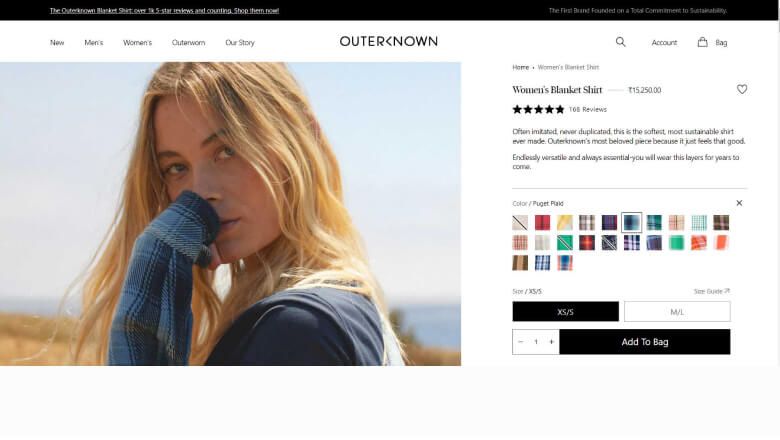
Awayco is a surf and snow gear rental service with informative and playful product descriptions that reflect the brand’s laid-back and adventurous spirit.
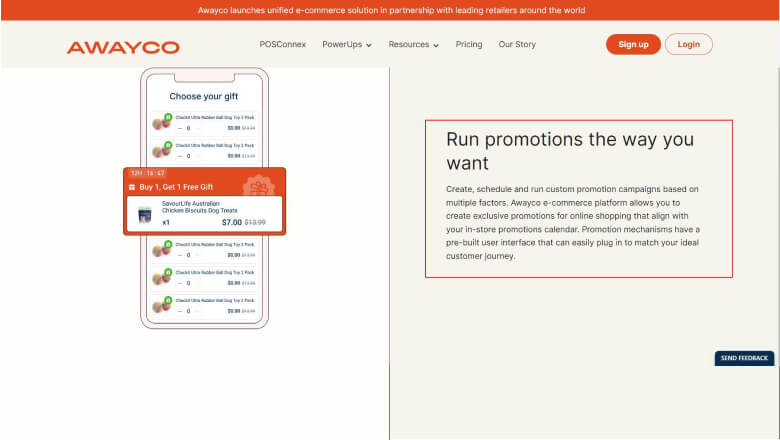
Build trust & FOMO
Highlight real-time activities like reviews, sales & sign-ups.
Headlines and Titles
Titles and headlines are the first things your reader will see on your page and your content writing, so it’s important to make them count.
Use Headlines to catch your readers’ attention and get them interested in what you have to say. Use Titles to give your content context for readers who may not know what they’re about to read.
The Role of Headlines in eCommerce Copywriting
The headline is the most important part of your e-commerce. It is what gets people to open your website and read them. That’s why it’s so important to write a great headline.
Your headline should always be short and sweet, but it needs to be catchy enough that people will want to click on it.
The best way to do this is by using an opinionated statement that tells the reader what you think about something, such as “Sneakers are for everyone” or “Sneakers are NOT for everyone.”
You can also use a question in your headline, like “Do you wear sneakers?”
This will get more people interested in reading your email because they want an answer!
Related post: 13 Stunning Ecommerce Landing Pages Examples
Techniques for crafting compelling headlines
Use action verbs and nouns that describe what’s happening. This is a good rule for writing all kinds of copy, but especially for headlines—you want people to know right away why they should be reading your story!
Use numbers and statistics where appropriate, especially if they’re relevant to your topic or industry.
You can use statistics to make your points stronger, but don’t just throw them in there!
Ask questions and answer them with your content (in the headline). For example: “What Is The Best Way To Eat Peanut Butter?” Or, “Is Peanut Butter Healthy?”
Use powerful words or numbers that evoke emotion in your audience (like “life-changing”).
A great example is this article from LifeHack called “5 Life-Changing Books Every Man Should Read.”
It immediately evokes feelings of change and growth, even though there aren’t any actual books mentioned in the title!
Examples
Sonos is a startup that provides software for audio sharing, and their website features attention-grabbing headlines such as “Sound, Meet Magic” and “Your Ears Deserve Better”.
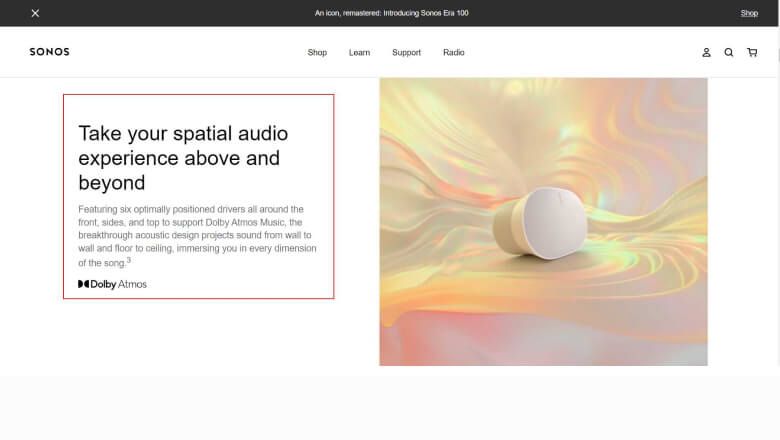
Enzyme is a software company that provides solutions for the life sciences industry. Their website features headlines such as “Power Your Lab with Precision” and “Simplify Your Regulatory Compliance”.
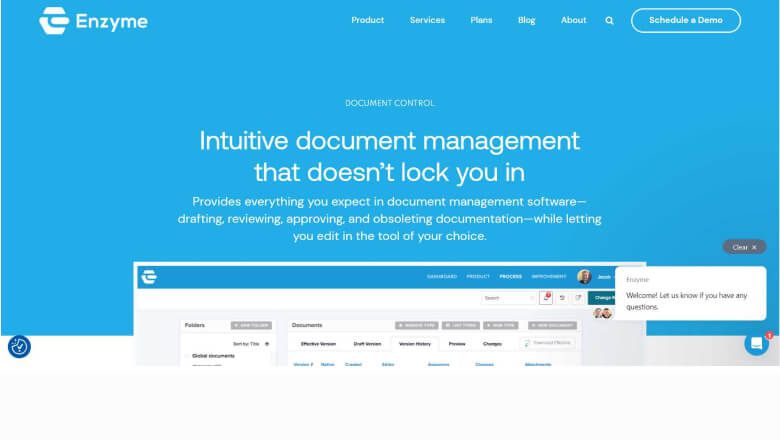
Call-to-Action Phrases
Call-to-action phrases are the words that compel readers to take action on your website.
They’re the most important part of your copy, and they’re what you should focus on when you’re writing a website.
Importance of strong CTAs in eCommerce copywriting
If you’ve ever been to an eCommerce site, you know that it’s easy to get lost in the sheer variety of products on offer.
You might find yourself clicking around the site for hours, never making a purchase because there are just too many options.
That’s why strong calls to action are so important.
The CTA is the button or links on your site that leads people from their browsing experience into an actionable one—whether that’s making a purchase or signing up for your newsletter.
It’s your best chance at getting customers to take action and make a purchase as quickly as possible.
And if you’re not using CTAs effectively, then you’re missing out on huge opportunities!
Techniques for Crafting Persuasive CTAs
Here are some of the best techniques for crafting persuasive CTAs:
Use a strong call to action: Your call to action is the purpose of your CTA, so make sure it is clear and concise.
If you have multiple CTAs on your page, make sure that each one serves a specific purpose.
Make sure your CTA stands out: Your CTA should stand out from the rest of your content.
You can do this by using different text colors or sizes, changing the font, or making it bold or italicized.
Add an image: You can use an image to get people’s attention and draw them into your copy—especially if your copy is full of text and numbers!
Just make sure that it isn’t too distracting for people who are trying to read!
Actionable. Instead of asking for a sale or a signup, ask for something specific that your reader can do right now, such as “Call us” or “Fill out this form.”
Simple and easy to understand. If you need to explain what the CTA means in detail, then it’s not simple enough!
Examples
The CTA for Yumbutter’s email subscription is “Join the Nut Butter Revolution” with a tone that is enthusiastic and inspiring, promoting their mission to create delicious and sustainable nut butter while empowering communities in need.
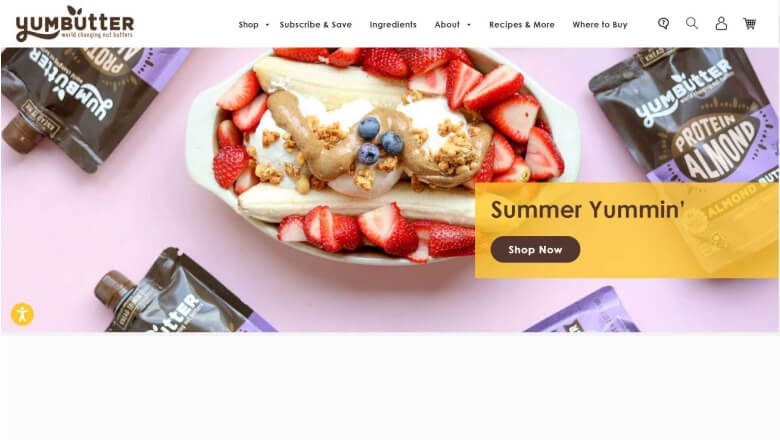
Artifact Uprising’s brand CTA is to “Create Your Story” through customizable photo books, prints, and gifts.
The brand’s tone is minimalist and authentic, emphasizing the importance of capturing and preserving meaningful moments.
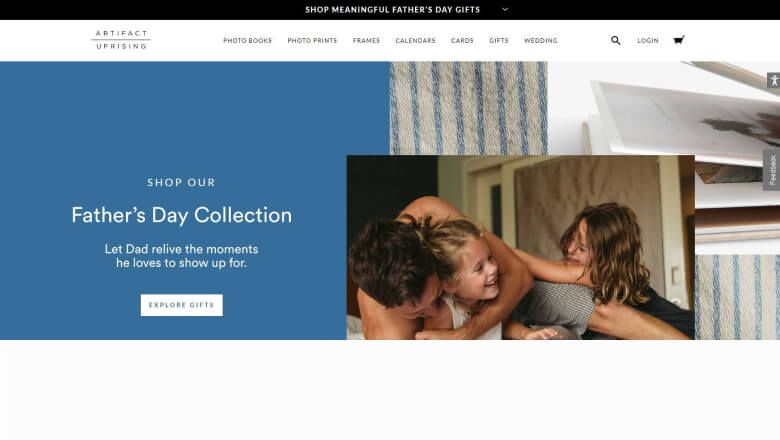
Landing Pages
Landing pages are a fundamental part of your eCommerce content marketing strategy.
They give you the ability to collect information about a customer before they make a purchase, and they help you build trust with your customers through content marketing.
Landing pages are an opportunity for you to tell your story in a way that is relevant and interesting to the person viewing it.
The goal of a landing page is to write compelling copy that will interest people enough to want to learn more about your product or service.
How landing pages can be used to boost eCommerce sales
Landing pages are a great way to boost e-commerce sales.
They’re designed with a single purpose: to get visitors to do what you want them to do, which in the case of eCommerce businesses is usually buying something.
Landing pages, including the category pages, can be used to increase the number of visitors who convert into customers and the amount they spend while they’re there.
The first step is designing an effective landing page.
You’ll want to make sure it clearly explains what you’re offering, why they should buy it, and how they can get started right away (by purchasing).
Then, you’ll need to optimize your landing page for conversions—that means making sure it loads as quickly as possible and is easy for people with different devices and browsers to see clearly.
You can also track your marketing campaign results and repeat customers to see which methods are working best for you!
Tips for writing effective landing page copy
1. Don’t be afraid to be funny
You’re writing for people, and people like to laugh. That doesn’t mean you should go for the lowest common denominator—just make sure you’re not being too serious.
2. Be specific and use numbers
If you have something to say, say it in a way that will grab your reader’s attention.
Be specific with your claims, use numbers if possible, and offer proof of what you’re saying with links or facts/statistics/testimonials.
3. Know your audience
If you have an existing customer base and target audience (for example, if you already sell products on Amazon), your landing page copy can be tailored to speak directly to them.
If not, consider who will be reading it (i.e., potential customers) and make sure that person is represented in your content.
Examples
Warby Parker is an eyewear company that offers affordable and stylish glasses. Its landing page is simple and sleek, with high-quality images of its products.
The company’s tone is confident and sophisticated, reflecting its brand’s commitment to quality and style.

Allbirds is a sustainable footwear company that creates shoes from natural materials. Their landing page features high-quality images of their products and a simple, clean layout.
The tone they use is warm and friendly, which reflects their brand’s commitment to sustainability and comfort.
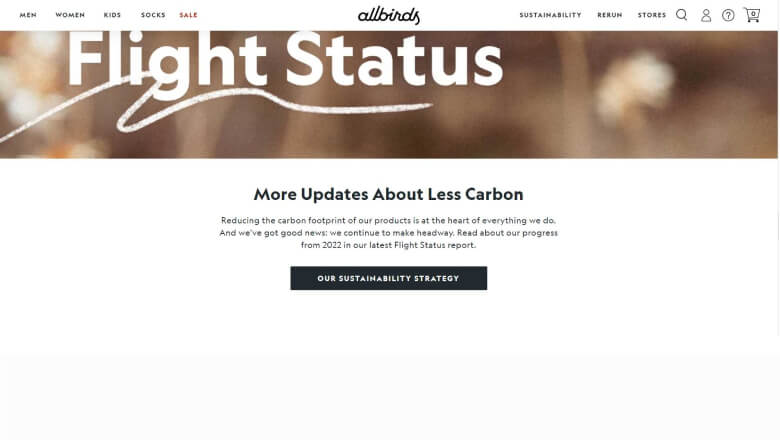
Build trust & FOMO
Highlight real-time activities like reviews, sales & sign-ups.
Email Copywriting
Email copywriting is the art of crafting email messages that get opened and read.
It’s a skill that’s incredibly important for salespeople and marketers, who often send dozens or hundreds of emails every day.
But even if you’re not in sales or marketing, writing effective emails and social media posts can help you achieve your goals in any area of life.
The Role of email marketing in eCommerce
Email marketing is one of the most important aspects of a company’s eCommerce strategy.
It’s an excellent way to reach customers and get them back into your store via search engines, but it can also be used as a tool for customer retention and loyalty.
Email marketing is one of the oldest forms of digital marketing, and it’s still going strong.
In fact, according to the Direct Marketing Association (DMA), email’s ROI (return on investment) is 25-100% higher than that of other digital channels like social media and display advertising.
This is because email allows you to build relationships with your customers and send them highly relevant messages that cater specifically to their interests—something you can’t do as effectively on other platforms.
So what does this mean for your business? It means that if you’re looking for ways to boost revenue and improve customer satisfaction with your e-commerce efforts, then email marketing should be at the top of your list!
Tips for writing effective marketing emails.
Keep it short, sweet, and to the point. The most effective marketing emails are brief and to the point.
If you have a long message to convey, consider breaking it up into multiple emails or including an opt-in form to encourage recipients to sign up for a more detailed follow-up.
Be personal! When writing your marketing emails as an e-commerce writer, address them to specific individuals (e.g., “Dear Joe”) rather than blindly sending mass emails to all of your contacts.
This will help ensure that your messages are more effective at connecting with your prospects and customers.
Use lots of bullets! People love bullet points! Bullet points help break up text into bite-sized pieces that are easier to digest quickly—and they look nice, too!
Use bold and italics sparingly, only when necessary, and make sure they’re used appropriately so as not to distract from the text in question (e.g., don’t use bold for emphasis).
Examples
Artifact Uprising is a company that specializes in creating high-quality photo albums, prints, and gifts.
Their email copywriting is warm, friendly, and personalized, making the reader feel like they’re receiving a message from a close friend.
Their tone is conversational, with a focus on storytelling and emotional connections.
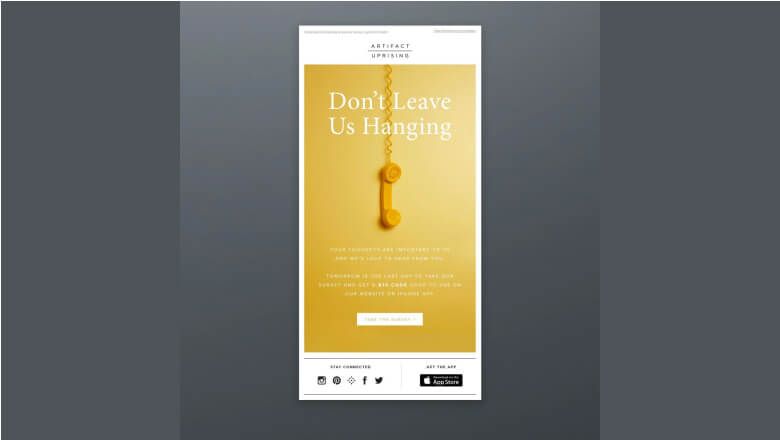
Knock Knock creates quirky and creative stationery and gifts. Their email copywriting is witty and playful and often features puns or clever wordplay.
They use a casual and conversational tone, with a focus on humor and creativity.
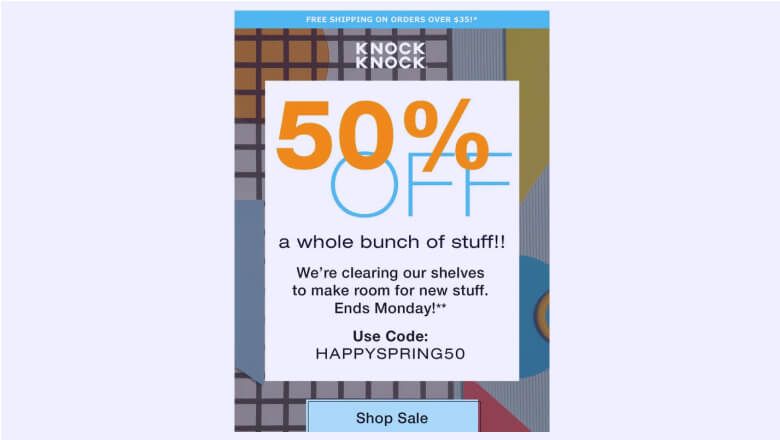
What are the common mistakes to avoid in eCommerce copywriting?
As an eCommerce copywriter, Copywriting, like any other skill, takes time to master. But there are certain common mistakes that you can avoid right away.
First, don’t try to be funny. Create a persuasive copy.
If you’re writing product descriptions or short copy for a landing page about product features, the last thing you want is for the copy to be funny—and the first thing your potential buyers will do is scroll past it because they’re looking for a reason to buy from you.
Second, don’t use words that aren’t familiar to your audience. Do proper keyword research.
You may think “lorem ipsum” sounds cool because it’s Latin and stuff, but most people won’t understand what you’re talking about, which means they’ll click away faster than you can say “lorem ipsum.”
Third, don’t make your audience work too hard for information! Provide enough detail about each product so that readers know what they’re getting into without having to read an entire book on the subject.
Conclusion
At the end of the day, it’s all about making people feel confident in their purchases.
And if you’re a business that sells products online, then you know how important good copywriting is.
Because if you can’t make people want to buy from you, then it won’t matter how good your product is—they’re never going to buy it.
So if you’re looking for ways to improve your eCommerce copywriting and boost sales, look no further than these 10 examples!
